The Jewel of the Danube
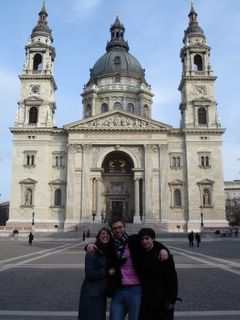
We successfully navigated the metro to the city center and spent some time trying to find hostels before giving up and heading to the tourist information office. We chose to stay at a quiet but centrally located hostel called the Red Bus. Our first stop after checking in and dropping our bags off was the monumental nearby St. Stephen's Basilica.
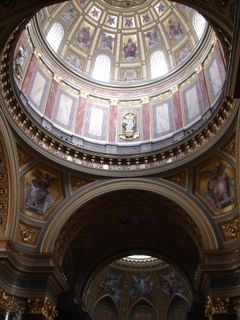
It had a fantastic interior and an even more interesting exhibit tucked away in a side chapel...
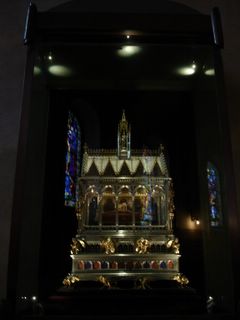
...the right hand of St. Stephen! Yes. The hand. It's inside the ornamental box, gnarled and shriveled like a shrunken monkey head.
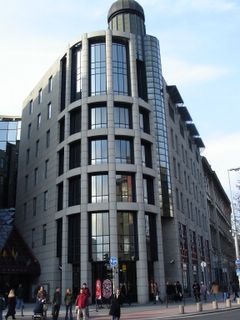
Every street in Budapest screamed with contradiction. Looking west from one avenue, we have this modern building.
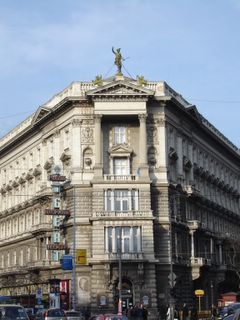
And looking east, something a bit more classic.
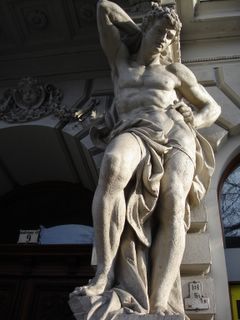
Fantastic statues decorated many of the arches along the epic Andrassy Utca boulevard, a 2.5 kilometer stretch of many of Budapest's finest buildings.

The Hungarian State Opera House. We explored the interior, hoping to buy tickets for an event Saturday night, but a massive white-tie ball was already scheduled and the $360 USD price tag was a bit too much for our budget.

Interesting street art near some other opera houses off Andrassy.
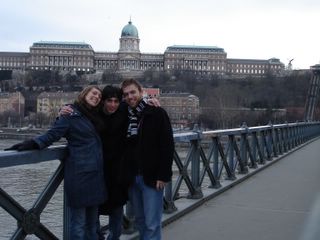
Crossing the Chain Bridge on our way to explore Buda. (Budapest is the unified entity of two cities, Buda and Pest, separated by the Danube River.) Behind us is the Buda Palace.
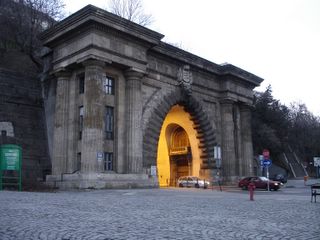
A particularly interesting looking tunnel.
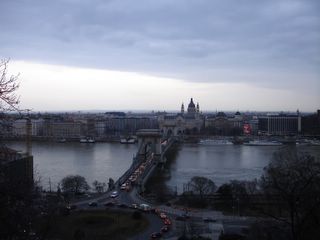
A cloudy Budapest evening viewed from Castle Hill.
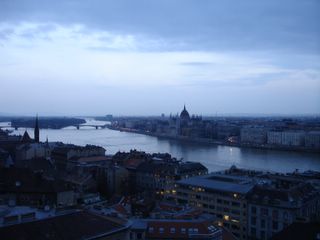
Look at all those spires. The large building near the middle of the picture is Parliament... we'd explore it a couple days later.

Night had set as we readied to return across the Chain Bridge.
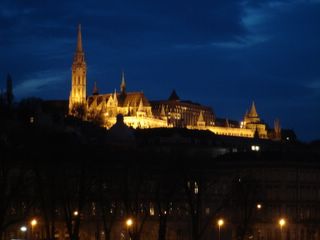
A glance back revealed the illuminated Fisherman's Bastion, a fantastic "white rampart with cloisters and seven turrets" that we'd also later investigate further.

An interesting set of iron chimes in Deak Ter. We weren't sure if we should play with it at 11pm, so we did the safe thing and crashed them into each other as hard as we could.
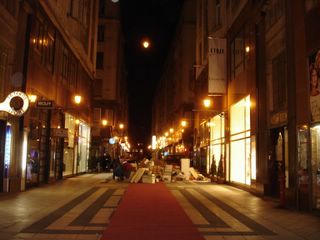
Another Hungarian contradiction: a rubbish pile on Vaci Utca, a posh shopping street laden with Gucci and Louis Vitton stores. Note the red carpet. We continued to wander the city at night and were stunned to discover enormous piles of rubbish every 30 or 40 meters, just stacked on sidewalks and pedestrian streets. It was an utterly bizarre, incredible sight that kept us baffled the entire evening. Some piles were free-for-alls, others were overseen by large, burly fellows haggling prices with stooped, elderly ladies. More than once we saw 75-year-old women hobbling along the metro with antique chairs or tables on their backs. BIZARRE. Even weirder, though... the next morning, every single pile had vanished, without a trace. The Budapest Public Services Department really impressed us. There were four garbage trucks on our small hostel street alone. As soon as it began to snow, huge teams of city workers appeared instantly, shoveling and laying down salt.
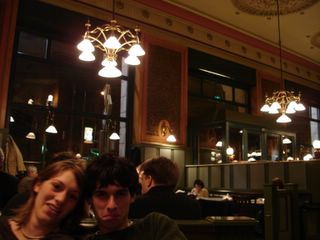
We took some coffee and cake in the classic Central Coffee House, "restored to its former glory." The ceiling was REALLY high. Ben was pouting because he was jealous of the delicious spaghetti I ordered.
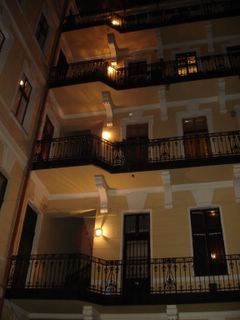
Our hostel courtyard at night...
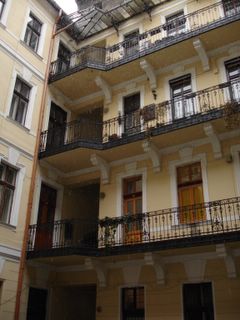
...and in the snowy morning. (Every morning was snowy.)
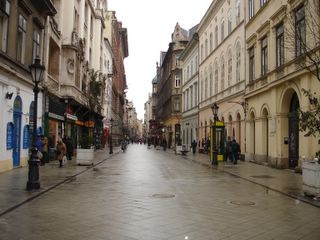
The touristy, but still enjoyable Raday Utca street.
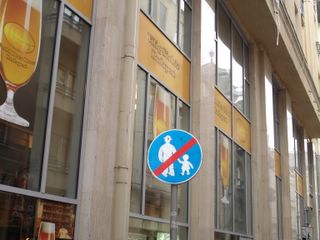
We weren't able to figure out what this sign meant.
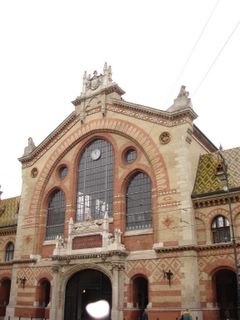
Early Saturday we went to the market, a gigantic affair housed inside this deceptively large building.
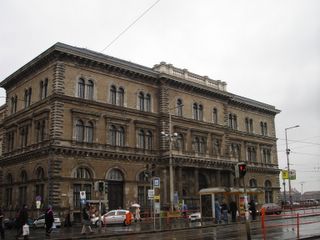
Next door was the Economics University where our French friend Sam "studied" for six months.
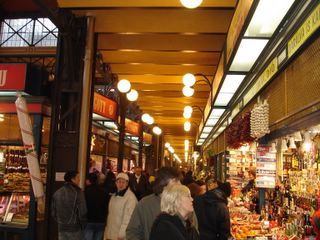
Unfortunately, the market was fearfully touristic, though it was still fun to walk up and down the long aisles. Almost every other stand was a butcher shop.
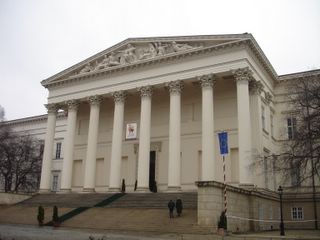
The Hungarian National Museum.
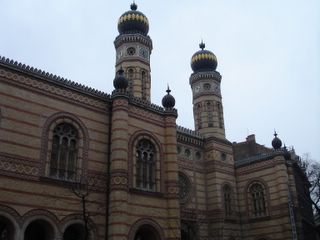
The main Jewish Synagogue was just a block from our hostel; we toured it the next day, Sunday.

We took the metro up to the Szechenyi baths, "one of Europe's largest spa complexes." We spent four hours wallowing in the baths; our favorite time was spent in the outdoor bath, like a giant hot tub, as the snow fell and steam swirled all around. We'd often lose sight of each other and have to take care not to bump into the old, fat Hungarian men also lounging in the bath. Rachel and I each paid $11 for a massage; mine started out comfortably but I think the Hungarian masseuse tried a little too fervently to relieve some of the tension in my back - it was red and a bit tender for hours afterwards. After we left the baths, we wandered around Varosliget City Park and explored the Vajdahunyad Castle.
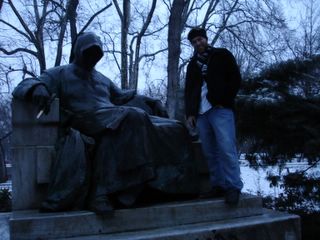
Perhaps my favorite statue in Budapest.
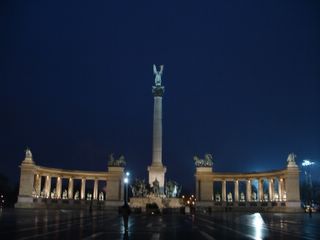
As we walked back to the city, we inspected the Millenium Monument, a spectacular feature dedicated to Hungary's finest heroes.
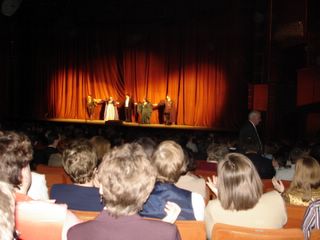
I neglected to mention earlier... while we were at the Hungarian State Opera House Friday, we learned of an opera Saturday night at the Erkel Theatre, the second house of the Hungarian state opera, and bought tickets for $10 each for "Il Trovatore" - The Troubadour. We went straight to the opera after splashing in the baths and thoroughly enjoyed the excellent 2h50 minute performance.
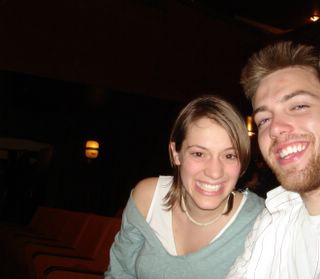
I only fell asleep for 6 minutes in the final act.
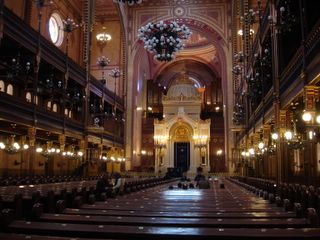
The next day we picked up Stephanie at Kobanya-Kispet and went to the Dohany Street synagogue after dropping her bags off at the hostel. It was ornamentally decorated and, we were told, the largest functioning synagogue in Europe.
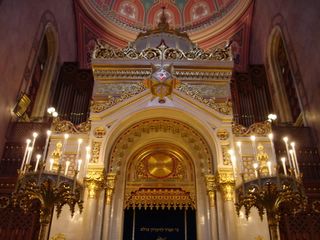
The Jewish three-dimensional representation of God.
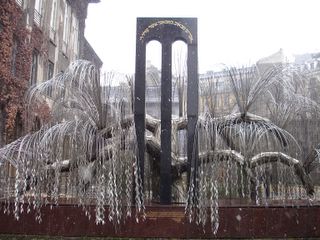
In the syangogue courtyard was a Holocaust memorial: an inverted menorah/weeping willow with thousands of metal tags inscribed with the names of Hungarian Jewish victims.
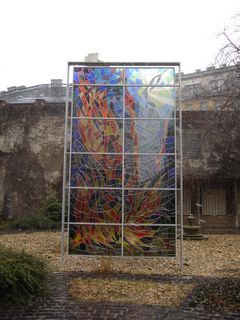
Nearby was another memorial, in stained glass: a coiled serpent rising out of flames. The empty panes around the glass represent the Jews who were cremated in the Holocaust, since Jewish law mandates the body be buried.
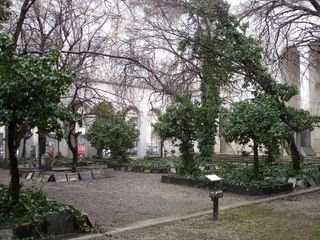
Another serene looking courtyard.
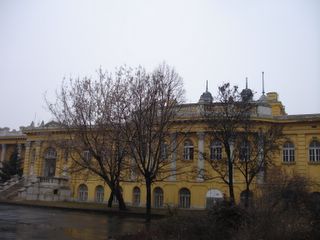
This is a bit out of order, but here's an exterior picture of Szechenyi baths complex.
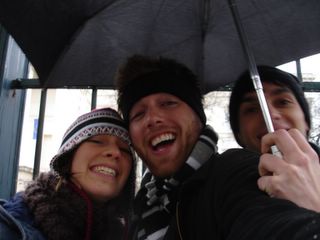
Singing in the rain!
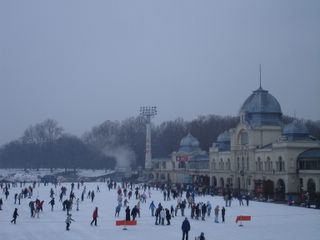
Perhaps the most interesting ice skating location I've seen.
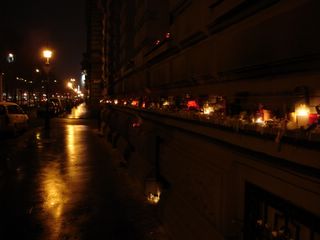
Flickering candles line the wall of the House of Terror, the best museum I've ever been to. It studied the tragic fate of Hungary in the 20th century; first under fascism during World War II and then under 40 years of communism. Even the very structure of the building was part of the museum: it's the former headquarters of both the fascist regime as well as the secret police who terrorized the population for four decades. It was intense, modern and haunting. Most of the exhibits were in Hungarian, but written English translations were available and by the end of our 1h45 minute tour (rushed, actually, because it's normally supposed to take 2.5 hours) we'd collected a hefty 30 sheets of paper. Perhaps the most chilling part of the museum was the very last exhibit, entitled "Collaborators," a wall listing the Hungarians who aided the fascists or communists, along with their names and birth dates. Many of them are still alive.
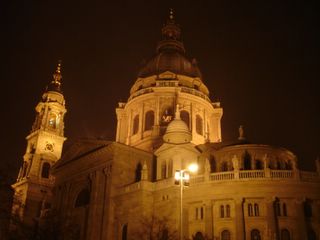
St. Stephen's at night.
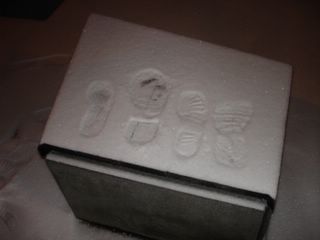
Comparing shoe sizes: Rachel's, mine, Stephanie's, Ben's. Yes, mine is the big foot. The Bigfoot.
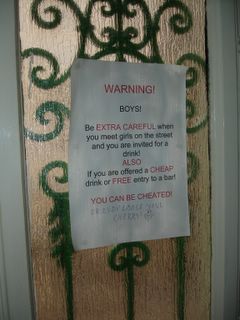
An interesting warning inside our hostel.

We discovered this frightening War of the Worlds-like device lurking near our hostel. I advised calling in a military airstrike (until further inspection revealed a "Traffic Camera" label on the back).
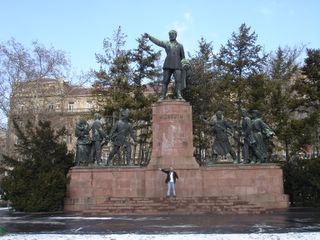
Leading Hungary forward!
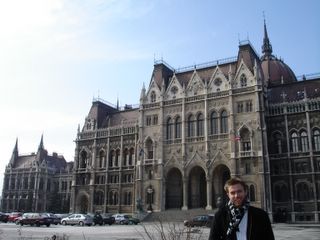
The back of Parliament.
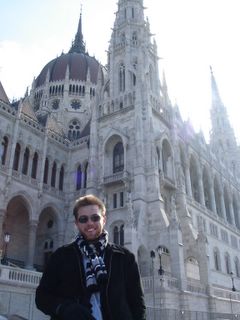
The slightly more picturesque reverse side of Parliament, facing the Danube.
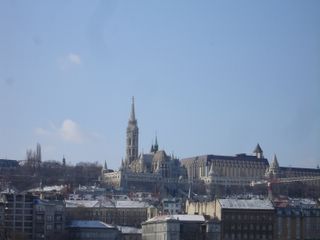
A glance across the river to the Fisherman's Bastion and Matthias Church.
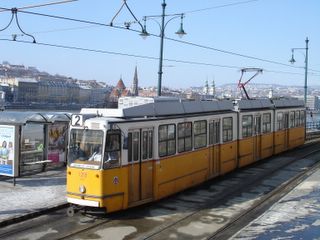
Faithful public transportation.
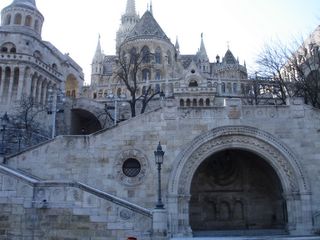
The Fisherman's Bastion up close.
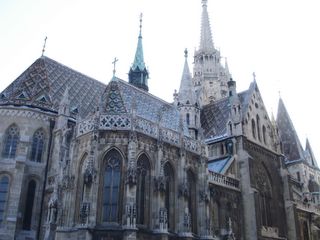
The nearby Matthias Church.
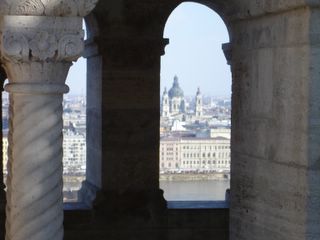
Inside the Bastion, St. Stephen's peeking through.

I think I lost that headband in Budapest.

King of the... Bastion.
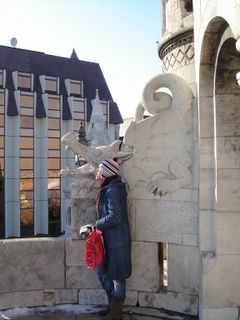
I can't tell which one's scarier.
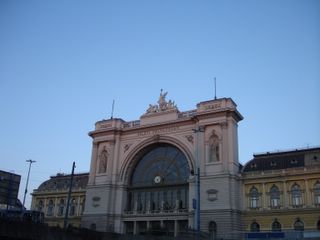
At 4:30pm Monday, we headed to Keleti train station, our departure point for... Zagreb, Croatia. An hour into the six-hour trip, we realized we'd purchased round-trip tickets, instead of one-way tickets, and were instantly upset at ourselves and the ticket counter woman for foisting higher expenses on us. Upon our return to Budapest a week later, though, we'd sheepishly discover that the round-trip tickets were, bizarrely, cheaper than one-way travel. Another Hungarian contradiction.

1 Comments:
How have you managed to see so much? It seems like time stands still there or you have 36 hours to a day.........WOW!!!
The pictures are great and your commentary is riveting.
Post a Comment
<< Home